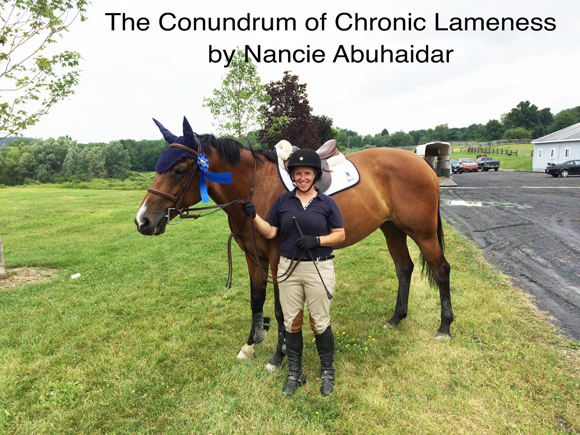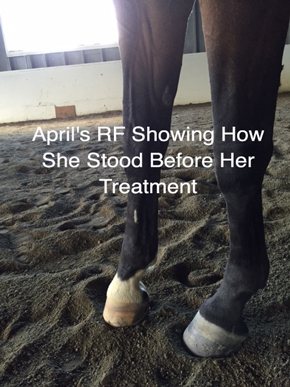The Conundrum of Chronic Lameness
by Nancie Abuhaidar

“Where’s your horse?” I was frequently asked this question while I was spectating at a local horse show.
I’ve been showing my mare, April for the past few years, but never consistently. She was frequently lame. Her lameness varied from not-quite-right to can’t-put-weight-on-the-foot. The culprit always appeared to be her right front hoof and time and observation narrowed it to the inside heel.
I knew this foot would be a potential problem; she came with a history of on and off lameness there. As an adult amateur with no loftier ambitions than possibly the three foot divisions, I thought a less stressful workload would help- and it did for a while.
I’m sure I’m not alone in keeping an extremely talented partner in the hopes we can fix the problem, and it is frustrating. Whatever discipline you chose to pursue, the comfort of the horse is paramount.
I consulted my veterinarian, which has to be one of the first steps in any evaluation. Similar to a lot of horse lovers, I don’t have a lot of money to throw away. Sure, there are many diagnostic tools available. Veterinary medicine has come a long way. Radiographs (x-rays) are now digital and instant. MRIs and nuclear scintigraphy/bone scans can provide us with detailed pictures of what is going on in our equine friends, but all of these therapies cost time and money.
It would be so much easier, and much cheaper, if they could speak.
We started with radiographs which showed no changes or abnormalities with the foot. When I jogged the mare, my vet only saw a slight shortness with the right hind. She attributed that to a lack of muscle from a two month layup.
The decision was made to leave her barefoot and she was sound for about six months with no medication except the occasional Bute after strenuous work. I am not a big believer in medication, but will use it to keep my horse comfortable.
Still, the problem came back. We’d treat it with rest and Bute and start again. The worst part is I could never predict when it would happen. When we finally put shoes on her, we added rim pads, which helped, for a while, but the lameness would come back—usually right before a show.
Nearly every time the vet saw her, she pointed to the right hind, not the right front. Her entire back was palpated sore. We tried stretching, and I bought a Back on Track sheet and bell boots, which seemed to help a lot. They bought us another six months of soundness.
My trainer began suggesting that I should inject her sacroiliac joint. I resisted strongly. I am not a believer that injecting steroids into joints is the cure-all for everything. I tried a course of Bute and Methocarbamol, with mixed results.
The vet group I use had recently hired a young vet who was certified in equine chiropractic. We gave it a shot and April improved, but again, only for a while.
The next lameness was severe. The poor girl was so lame, it was hard to tell where the problem was. The vet watched her go on a lunge line and April could barely trot. Could this be Lyme Disease? EPM? Wobblers or another neurological problem? I was devastated. The vet ruled out the likeliness of EPM and neurological problems with a few in-hand tests, and a Lyme titer came back lower than a previous test.
Then the vet flexed her hind legs. April nearly fell down. The vet concurred with my trainer, and the decision was made to inject her hocks. Synovial fluid should be thick and viscous, and the fluid from her right hock was as thin as water. Could all of her right front lameness be caused by a hind end issue? It looked likely.
Following the hock injections, we had eighty percent improvement. I had the vet out for a re-check and an adjustment. We put April on the lunge line and she was about a 3/5 lame. After chiropractic, the change was astounding; she was now 0.5/5 lame and it was clearly the right front.
 Without an MRI, my vet could not accurately diagnose whatever problem lurked in April’s right front foot, but with all that we had, she believed that there is was a soft tissue issue that flared up. What we now know, is because of the pain in her hocks, April began putting most of her weight on her front feet instead of carrying herself through her back. The hock issue made her back too sore to take the stress. Since I have owned her, April has always travelled on her forehand. The added stress to her front end made the sensitive right front foot more vulnerable.
Without an MRI, my vet could not accurately diagnose whatever problem lurked in April’s right front foot, but with all that we had, she believed that there is was a soft tissue issue that flared up. What we now know, is because of the pain in her hocks, April began putting most of her weight on her front feet instead of carrying herself through her back. The hock issue made her back too sore to take the stress. Since I have owned her, April has always travelled on her forehand. The added stress to her front end made the sensitive right front foot more vulnerable.
As my vet and I came up with a long term treatment plan, we debated the benefits and risks of the various injectable joint formulations available. After a lot of online research, and with the agreement of my vet, I started April on a course of Pentosan, a compounded medication similar to Adequan and Legend. It is approved in Australia, but in the US it is only approved as a post surgical lavage. Still, we figured it could only help.
The difference is nothing short of amazing. Within weeks, I now have a horse that is sounder than she has ever been. We are now working correctly, straight and forward, back to front. She can collect, and she no longer drags herself along on her forehand. We are doing small gymnastics. It is a process, but the biggest reward I have is a horse that is happier and seems to enjoy her work. That is what matters most.
There are so many ways to address lameness and it is invaluable to have a vet or team of professionals willing to work together in the best interest of the horse. Every case is different, but sometimes the obvious cause is just another symptom of a bigger issue. With all of the proven alternative treatments, such as chiropractic and acupuncture, as well as modern diagnostic technologies, those of us dealing with complex or chronic soundness issues have hope that our beloved partners can return to soundness.
I know not every chronic lameness can be cured. I had every expectation that April would become a broodmare or my pasture pet. However, sometimes, looking deeper and thinking outside the box can be nothing short of astounding.


